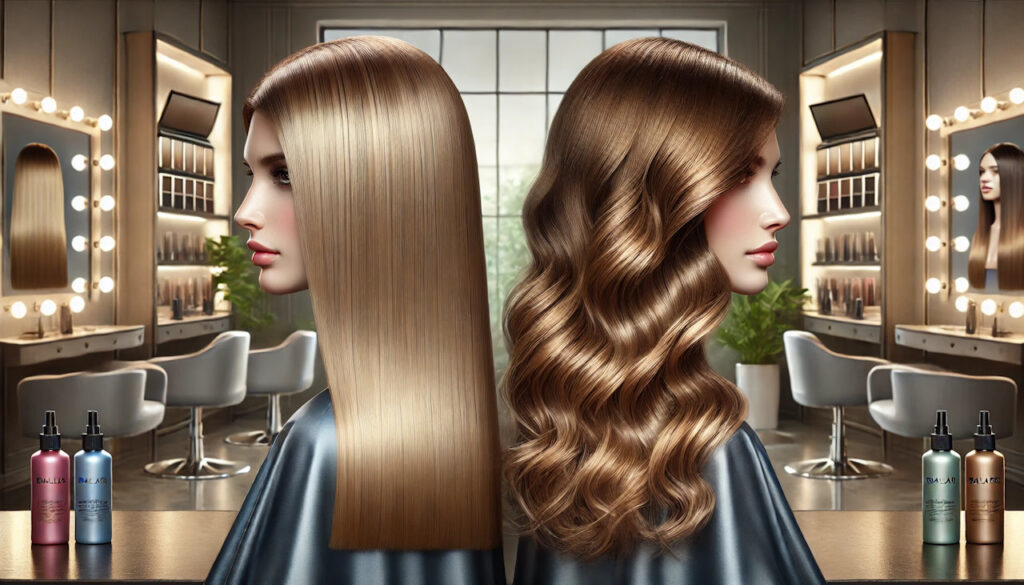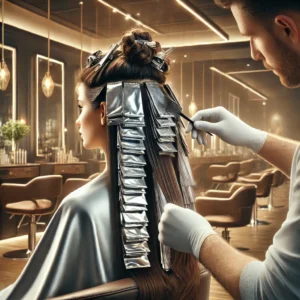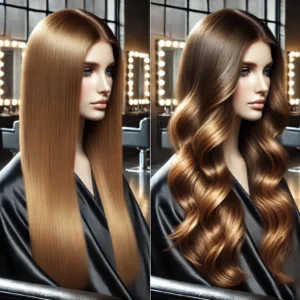Explore the Distinct Features of Foiling and Balayage Hair Highlighting Techniques for Stunning Transformations
When considering transformative hair highlighting techniques, foiling and balayage emerge as two of the most sought-after methods that can significantly elevate your hairstyle. Both techniques aim to enhance your locks with highlights, yet they diverge in their application techniques and the aesthetic results they yield. Foiling employs a traditional method in which selected sections of hair are meticulously wrapped in foil after being treated with a lightener or dye. This precise technique allows for exceptional highlight placement, making it the preferred choice for those desiring distinct and well-defined results.
This careful technique results in a polished and defined hairstyle, perfect for individuals seeking a dramatic transformation or a striking contrast against their base color. In contrast, balayage offers a more artistic approach, where the stylist applies color directly to the hair using a hand-painting technique. This method emphasizes the mid-lengths and ends while preserving darker roots, creating an effortless and sun-kissed look. The gentle transitions characteristic of balayage often require less frequent maintenance, making it an attractive option for individuals who prefer a relaxed and natural appearance that evolves beautifully over time.
Understanding these essential differences is vital for making an informed decision that aligns with your unique personal style and daily lifestyle requirements.

Essential Factors to Consider When Choosing Between Foiling and Balayage
- Foiling involves wrapping individual sections of hair in foil to achieve precise and uniform highlights, whereas balayage utilizes a freehand technique that creates a more organic, sun-kissed effect.
- Foiling offers benefits such as the ability to achieve consistent and controlled results, effectively lightening hair shades; however, it may lead to noticeable regrowth and can result in a more structured, less natural appearance.
- In contrast, balayage is highly regarded for its low-maintenance quality and seamless integration with your natural hair color. However, potential downsides include uneven color distribution and the requirement for regular touch-ups.
- Those with dark, thick, or coarse hair may find foiling particularly advantageous, especially if they desire a dramatic, high-contrast look.
- On the other hand, balayage is often ideal for individuals with fine or thin hair, offering a subtle, blended effect that minimizes regrowth visibility.
- To maintain foiled highlights, it is crucial to use colour-safe products, limit excessive heat styling, and schedule regular touch-up appointments with your stylist to ensure your highlights remain vibrant.
- For balayage, it’s important to use colour-safe products, reduce sun exposure, and have regular toning sessions with your stylist to maintain a fresh and lively appearance.
- When deciding between foiling and balayage, consider your desired aesthetic, hair type, maintenance preferences, and budget to make the best choice based on your individual understanding of the benefits and challenges of each technique.
 Discover the Advantages of Foiling: Why It Remains a Top Choice
Discover the Advantages of Foiling: Why It Remains a Top Choice
Foiling presents numerous advantages that establish it as a preferred choice for individuals seeking vibrant and eye-catching highlights. The most significant benefit lies in its precision; each section of hair is meticulously wrapped in foil, allowing for accurate color application exactly where desired. This level of detail is particularly beneficial for those with darker hair aiming to achieve substantial lift or contrast, resulting in a striking visual impact.
Additionally, the uniform appearance achieved through foiling makes it an excellent option for anyone who prefers a polished and sophisticated finish. However, it is essential to consider the downsides of this technique. The foiling process can be time-consuming, often taking several hours, especially for individuals with long or thick hair. Furthermore, the foils can trap heat, intensifying the lightening process, which may lead to hair damage if not carefully monitored. If you lead a busy lifestyle or prefer a more effortless hair care routine, foiling may require more maintenance than you are prepared to handle.
Examining the Benefits and Drawbacks of Balayage
Balayage offers several advantages that appeal to those desiring a more natural, effortless hairstyle. A standout benefit of this technique is its low-maintenance quality. Since balayage highlights are designed to mimic natural sun exposure, they grow out gracefully, avoiding harsh lines or noticeable regrowth. This feature translates to fewer salon visits for touch-ups, making balayage an excellent choice for individuals with demanding schedules.
However, it is critical to acknowledge that balayage may not deliver the same level of contrast as foiling. If you seek bold, dramatic highlights, you might find that balayage does not meet your expectations for intensity. Moreover, the success of balayage largely relies on the stylist's skill and artistry; therefore, selecting a seasoned professional who can interpret and implement your vision is crucial for achieving your desired results.
Identify the Hair Types That Benefit Most from Foiling Techniques
Foiling is particularly advantageous for specific hair types and textures. For individuals with thick or coarse hair, foiling can create vibrant highlights that distinctly contrast with the natural base color. The precision afforded by foiling allows for targeted color placement, enhancing the hair's natural texture and dimension. Furthermore, those with naturally dark hair seeking significant lift or contrast often find foiling to be the most effective method of achieving their desired look.
Even individuals with fine or thin hair can benefit from foiling, as this technique can create an illusion of volume and depth. By strategically placing highlights throughout the hair, you can add dimension that makes your locks appear fuller and more dynamic. However, if your hair is overly damaged or fragile, it is crucial to consult with your stylist before opting for foiling, as the process can be more taxing on delicate strands and may exacerbate existing issues, potentially leading to further damage.
 Discover Which Hair Types Are Perfectly Suited for Balayage Techniques
Discover Which Hair Types Are Perfectly Suited for Balayage Techniques
Balayage excels in versatility and adaptability across various hair types, making it a favored choice among many. If you have naturally wavy or curly hair, this technique enhances your texture while delivering an effortlessly chic sun-kissed effect. The freehand application method allows for gentle transitions between colors, making it particularly suited for those seeking an organic look that beautifully complements their natural waves.
Straight hair also benefits from balayage, as it introduces movement and dimension without overwhelming the base color. For individuals with fine hair, balayage can create an illusion of thickness by adding depth through strategically placed highlights. However, if your hair is very dark and you desire a dramatic change, keep in mind that balayage may necessitate multiple sessions to achieve the desired brightness, especially when compared to the more immediate results offered by foiling.
Effective Strategies for Maintaining Your Foiled Highlights
Maintaining foiled highlights demands a commitment to keeping your color vibrant and fresh. A critical step in this process is using sulfate-free shampoos and conditioners specifically formulated for color-treated hair. These specialized products help to preserve your highlights while preventing fading and damage that can occur with regular cleansing routines.
Additionally, incorporating a deep conditioning treatment into your hair care routine at least once a week is essential for keeping your hair hydrated, nourished, and healthy. Regular salon visits also play a key role in maintaining the integrity of foiled highlights. Depending on your hair growth rate and how noticeable your regrowth may be, you might need touch-ups every 6 to 8 weeks. During these appointments, your stylist can refresh your highlights and ensure they remain vibrant and seamlessly integrated with your base color. Lastly, take proactive measures to protect your hair from heat damage by applying heat protectants before using styling tools and limiting exposure to high temperatures whenever possible.
Best Practices for Caring for Your Balayage Highlights
Caring for balayage highlights is generally more straightforward and requires less effort than maintaining foiled highlights due to their inherently low-maintenance nature. Select colour-safe shampoos and conditioners that nourish your hair without stripping away color to keep your balayage looking exceptional. Choose products enriched with natural oils or proteins to help maintain moisture levels while enhancing overall shine.
While balayage requires fewer touch-ups compared to foiling, regular salon visits still remain essential to keep your color looking fresh and vibrant. Depending on your hair growth rate and how much lightening you desire over time, consider scheduling appointments every 8 to 12 weeks for a refresh. During these visits, your stylist can assess your hair's health and make any necessary adjustments to maintain that beautiful, sun-kissed effect you wish to achieve.
 Making the Right Choice: Foiling vs. Balayage Highlighting Techniques
Making the Right Choice: Foiling vs. Balayage Highlighting Techniques
Ultimately, your decision between foiling and balayage should be influenced by your personal style preferences and lifestyle considerations. If you are seeking bold, defined highlights with a polished finish, foiling may be the most suitable choice for you. This technique allows for precise color placement and can create stunning contrasts that make a powerful statement.
On the other hand, balayage may be the ideal option if you prefer a natural look that demands less maintenance. This technique offers versatility and adaptability for various hair types while providing an effortlessly chic aesthetic that matures beautifully over time. When making your decision, consider your hair type, desired maintenance level, and overall visual aesthetic. Both foiling and balayage come with unique benefits and challenges. By understanding these differences and evaluating your style alongside your lifestyle needs, you can confidently select the technique that aligns best with your aspirations. Whether you choose the precision of foiling or the effortless beauty of balayage, both methods can greatly enhance your look and elevate your confidence.
Your Most Common Questions Addressed
What is involved in the foiling technique for hair coloring?
Foiling is a highlighting method that entails isolating sections of hair, which are then wrapped in foil prior to applying color. This approach facilitates precise placement of highlights, resulting in a uniform and controlled color effect throughout the hair.
What distinguishes the balayage highlighting technique?
Balayage is a highlighting method where color is hand-painted directly onto the hair to produce a natural, sun-kissed effect. This technique allows for softer transitions and a more blended appearance, resulting in highlights that grow out seamlessly and naturally.
How do foiling and balayage differ from one another?
Foiling produces a more uniform, all-over color effect with precise highlight placement, while balayage offers a more natural, sun-kissed appearance characterized by softer, blended highlights. Typically, foiling necessitates more maintenance due to visible regrowth, whereas balayage grows out more smoothly and subtly.
Which highlighting technique is best suited for my hair type?
The choice between foiling and balayage hinges on your desired look and maintenance preferences. If you favor a uniform color with precise highlight placement, foiling might be the ideal fit. Conversely, if you desire a natural, sun-kissed appearance with softer highlights and less visible regrowth, balayage is likely the better option. Consulting with a professional hairstylist can provide personalized guidance based on your hair type and desired outcomes.
Presented By: Hair Foiling
The Article: Highlighting Techniques: Foiling vs. Balayage Explained appeared first on Amitys Hair Salon.
The Article Foiling vs. Balayage: Key Highlighting Techniques Explained Was Found On https://limitsofstrategy.com

